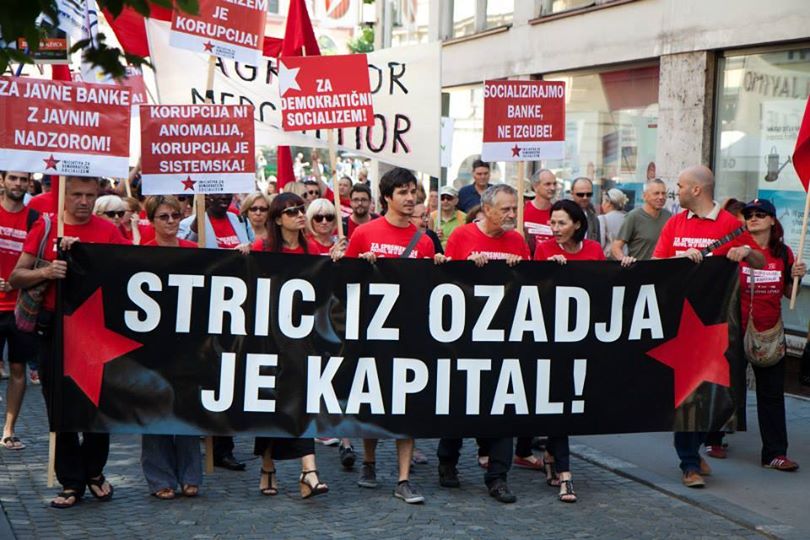The European Left: All Eyes On Slovenia

The Left in Europe has shown glimpses of electoral success recently in both Greece and Spain. Even a grey-haired, bearded, self-titled socialist has been elected as the leader of the Labour party in the United Kingdom with a enormous mandate. Yet, the Left in Europe is still struggling to make any significant impact on the wider politics of Europe. Why is this? The common answer would be that the Left is too busy talking to itself; trying to figure out why the proletariat won’t behave like Karl said they would. Or perhaps the Left is unable to make people feel safe and secure in the general ambivalence of our time? It is truly unfortunate that these answers have some (I repeat: some!) truth in them because a unified, transparent, and radical Left is needed more than ever within Europe.
The stories and successes of Syriza and Podemos have been covered at length and we have all followed them; expectant and hopeful. We have been rewarded with glimmers of possibilities for a stronger Left in Europe but the sweetness of the successes has, at times, had a bitter after taste.
A party we should all be paying more attention to is the United Left in Slovenia: a left-wing electoral alliance in Slovenia, between the Democratic Labour Party (DSD), Party for Sustainable Development of Slovenia (TRS), and Initiative for Democratic Socialism (IDS) founded in 2014 as a socialist and eurosceptic challenge to the European Parliamentary elections of the same year. The United Left is young, vibrant, media-savy, and undeniably conscious of their role as a grassroots political movement. Oh, and they actually stand a chance of winning a parliamentary majority in the next election. In Slovenia there appears to be an optimal fecundity for left-wing advance within the political realm. Slovenia has relatively strong trade unions who are willing to collaborate with the radical Left; the values of the old revolutionary Liberation Front are kept alive through a mass organisation, the Alliance of Fighters; ‘Yugonostalgia’ is also an important element in the Slovenian cultural formation, thus allowing and certain arguments about socialism to be made in the public sphere.
Like the recent Leftist parties we have seen emerge in Europe, the United Left started as a protest movement. In 2012 and 2013 hoards of disgruntled Slovenians descended on the streets of Maribor – Slovenia’s second city – to protest against the corruption of city mayor Franc Kangler, Ljubljana city mayor Zoran Janković, and the right-wing Slovenian Democratic Party government led by Janez Janša. The protests broke out in Maribor and quickly spread to other urban centres, including the capital Ljubljana. The protests were driven in the first instance by ruling-class political corruption, which fused into a wider discontent about the economic crisis and the austerity measures which were imposed on Slovenia as a result. The United Left has created a leftist movement that is made up of “well-educated, precarious students, and young people just joining the labour market” who have rallied behind their unifying rhetoric of change. The fact that the majority of their support comes from well educated young people emphasises a shift that it is occurring in the support for radical Leftist movements in Europe. Paolo Chiocchetti, a political scientist at King’s College London, has noted that the support for radical Leftist movements in Europe is emanating from white-collar, educated young people. The traditional electoral basis for Leftist movements no longer appears to be older, typically male industrial workers which resonates with the electoral successes of other Leftist movements in Europe; namely Podemos and Syriza.
The United Left appear to be relishing in the momentum they have gained since their birth. Yet there are still many walls they need to climb – walls that all Leftist movements have to scramble over. Firstly, the United Left need to have mechanisms in place to ensure that they too do not internalise the parliamentary logic that accompanies parliamentary democracies. The United Left has to remain a grassroots, anti-systemic party in order to sustain support and challenge the status quo. Rok Kogej, a member of one of United Left’s constituent organisations, believes that they have learnt from the mistakes of Syriza, and that the Slovenian environment is much more favourable for electoral success. Kogej purports that as Syriza “became integrated into the parliamentary system and became more of an electoral than a socialist force, the leadership became more and more distant from the party. The link between the mass base and the party leadership was broken, such that the leadership didn’t even listen to decisions of the central committee; it became totally autonomous”. Kogej explains that this sort of problem is not only organisational problem, it “is structural. It comes from being integrated into the logic of corporate media and so on. Basically in today’s political format, the media demand that the organisation has some kind of ‘face’”. The Slovenian state is fairly ‘young’ when compared with the likes of Greece, and therefore does not have a deep state which links “right-wing organisations to legal/police networks”.
The knowledge and existential awareness of the United Left and their position within the state apparatus is both invigorating and refreshing. However, the question still remains as to how they will harness capitalism for their socialist programmes. This is one of the greatest conundrums for the Left. The answer – I’m afraid to say – will not be found within this rather brief account of a political party in Slovenia. But nonetheless, the United Left does provide us with an interesting case study for us all to follow and study. The manner in which they deal with the problems of parliamentarianism, austerity, and the EU will provide the Left with a treasure trove of innumerable insights. So, if you would be so kind, please watch this space.



